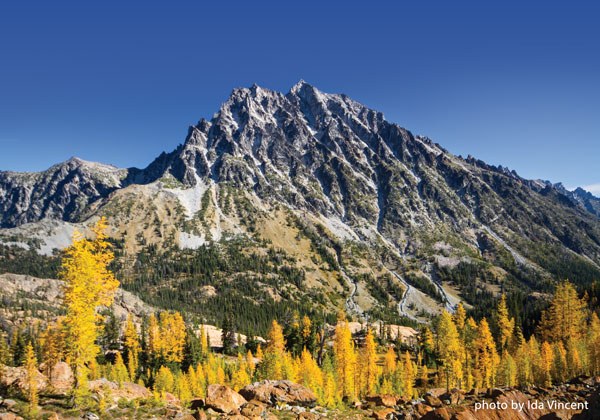
by Ida Vincent, Mountaineers Climb leader
With headlamps switched on, we started up the Ingalls Creek trail. The first rays of dawn followed behind, ready to bask the forest in gold, while our lamps illuminated the trail in front — guiding us up and over the pass.
By the time we reached Ingalls Lake, the sun was shining on our destination: Mount Stuart. We knew we had a long day ahead. Mount Stuart is notorious for its extensive scramble, followed by a few pitches of 5.6 climbing. With both excitement and trepidation, I put my hands on the rock and began.
We caught up to the few parties ahead at Long John Tower, but the sound of loose rocks cascading down ensured we kept a safe distance behind. Biding our time until clumsy feet passed, we gingerly made our way up, careful not to send any rocks down the gully below.
The west ridge of Mount Stuart is a maze of rock and gullies — making route finding challenging, which was evident by the many bivvy spots we passed. However, we had a secret weapon: Alex had been here before and knew the way. She’s not just a proficient climber, but an observant and attentive one. She made sure we took the right route, even when some of us doubted her direction.
A spicy butt-scooch down an exposed ramp, a tricky traverse, a slide through a cannon hole — and did I mention, lots of scrambling? It was with great relief that we finally reached the desired notch and could untie the ropes from our packs, put on our harnesses and start climbing the summit pyramid. There is a rumored easier 5.4 option but by now, we knew to listen to Alex and took the 5.6 route she was familiar with.
The climbing was fun, even if the pitches were short. In fact, we were surprised when we reached the summit, expecting more climbing. Topping out, we could spot Ingalls Lake far below and the Enchantments soaring behind. But we didn’t linger — dark clouds were racing in and we had a long way down.
Traversing over to the false summit we spotted the cave that had been our intended bivvy spot, but with time on our side, we started down the Cascadian Couloir instead. By now raindrops were soaking our jackets and the easy third-class scramble down was slick with moisture. Darkness was yet again forcing us to don our head lamps as we hiked. We didn’t wander for long in the dark, setting up bivvys at the campsite by the creek.
The next morning, the clouds and rain had dissipated, and a brilliant sun warmed our backs as we hiked out.
Before heading down the last few miles to the cars, we stopped and looked back at the mountain behind us. From September to early October, the landscape is aglow with Alpine larches — a unique conifer that turns yellow and sheds its needles every fall. They are hardy, fire-resistant trees that grow in rocky terrain at high altitudes, and can live over 1,000 years. Their abundance here gives Mount Stuart — the second-highest non-volcanic peak in Washington state, a deservedly breathtaking setting in which to show off.
It seemed almost impossible that the day before, we stood on the summit of that large, glorious rock.
 Ida Kaller-Vincent
Ida Kaller-Vincent